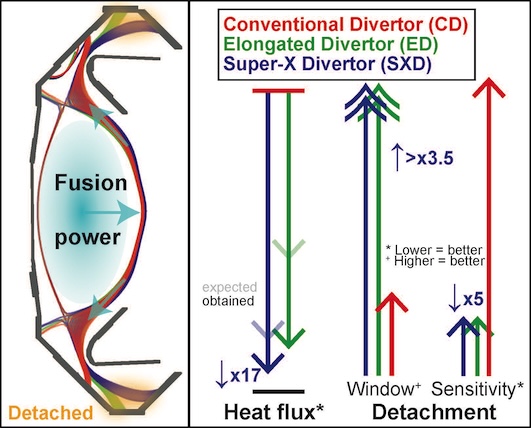Speaker
Description
Fusion energy is accelerating through conventional (DEMO) and alternative compact reactor designs, that are potentially faster and cheaper to build (e.g., ARC, STEP). Power exhaust is a key challenge and a potential show-stopper for all these designs. Recent experiment show the key benefits of strongly shaped Alternative Divertor Configurations (ADCs) [1-4], demonstrating their potential as a power exhaust solution. Integration of ADCs in a reactor is complex: a compromise between power exhaust benefits and engineering feasibility is required [5]. Our experiments show that a continuum of ADC optimisation strategies exists: modest, yet strategic, divertor shaping can greatly enhance power exhaust performance [3] and control [4].
To study this continuum the Super-X, Conventional and an intermediate Elongated Divertor geometry (see figure [3]) were compared on MAST Upgrade. The Elongated Divertor has only half the total flux expansion increase of MAST-U’s Super-X divertor: lower than that of STEP [7] and comparable to that of SPARC [8], ARC [9] and the DEMO Super-X Divertor [6].

Crucially, the key benefits of the MAST-U Super-X Divertor over the Conventional Divertor are maintained in the moderately shaped Elongated Divertor.
- Target heat loads are reduced beyond geometric spreading expectations.
- The sensitivity of detachment is drastically reduced, improving real-time power exhaust control [4].
- Reducing the detachment onset without any adverse core impact increases the operational window of the detached regime. This improved core-edge compatibility can enable reactor operation at lower core power losses [6] and/or lower upstream densities/fuelling (relevant for ELM-free scenarios and fuel cycle limitations [7]) and/or lower impurity concentrations.
Studying the physics driving these ADC benefits provides lessons on both divertor design – relevant for reactors - and exhaust physics/simulations and control [4] – relevant for ITER. This shows synergies between neutral baffling, poloidal leg length and total flux expansion enable power exhaust benefits from strategic divertor shaping; consistent with reduced and full models. This demonstrates ADCs offer a continuum of solutions, from modest to advanced, enabling balancing engineering complexity and reactor power exhaust performance, that can be tuned to an individual reactor’s specification.
[1 ] K. Lee. PRL. 2025. C. Theiler, this meeting. [2] D. Moulton. NF, 2024. [3] K. Verhaegh. Comm. Phys. 2025. [4] B. Kool. Nat. Energy, 2025, in press. This meeting. [5] R. Kembleton. FED 2022. [6] Xiang. 2021, NF; [7] Henderson. NF 2025; [8] Kuang, et al. JPP 2020; [9] Wigram, NF, 2019.
| Speaker's title | Mr |
|---|---|
| Speaker's Affiliation | Eindhoven University of Technology, Eindhoven |
| Member State or IGO | Netherlands, Kingdom of the |
